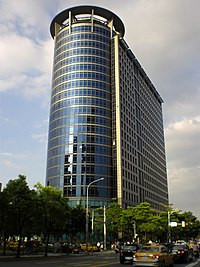
Photo from wikipedia
Heavy metal pollution has resulted in numerous environmental challenges. However, classic approaches, involving the use of solid adsorbents are subject to limitations, including the high energy consumption required for processing… Click to show full abstract
Heavy metal pollution has resulted in numerous environmental challenges. However, classic approaches, involving the use of solid adsorbents are subject to limitations, including the high energy consumption required for processing before and after use. Accordingly, strategies that facilitate the use of metal capture media that extends beyond waste remediation are attractive. Herein, a porous fluorescent aerogel (CPC aerogel) is constructed by immersing amino-based carbon dots (CDs-NH2 ) into a polyethyleneimine (PEI)/carboxymethylated cellulose (CMC) aerogel network for the simultaneous detection and adsorption of Cr(VI). Adsorption experiments confirm that the CMC/PEI containing CDs-NH2 aerogel (CPC aerogel) exhibits good Cr(VI) extraction capacity, and can reach a level that conforms with industrial water safety standards. In addition, the CPC aerogel can continuously detect and remove Cr(VI) at high flux. Following Cr(VI) absorption, the CPC aerogel may be vulcanized (MSx -CPC gel) and used for solar thermoelectric generation resulting in power generation. Additionally, the MSx -CPC gel can be used for solar steam generation and exhibits excellent evaporation rates of ≈1.31 kg m-2 h-1 under one sun irradiation. The results serve to underscore how materials designed for metal ion recognition and adsorption once exhausted can be exploited to provide materials for solar thermoelectric power generation and seawater desalination.
Journal Title: Small
Year Published: 2022
Link to full text (if available)
Share on Social Media: Sign Up to like & get
recommendations!